ACCM4300 Financial Reporting: Consolidated Financial Statements
VerifiedAdded on 2023/03/31
|9
|1594
|301
Report
AI Summary
This report addresses financial accounting and reporting issues related to consolidated financial statements, focusing on Power Ltd's acquisition of Cargo Ltd. It discusses the treatment of assets and liabilities during business combinations, emphasizing the importance of fair market value adjustments and the use of the Business Combination Valuation Reserve account. The report also covers the elimination of intercompany transactions and the subsequent transfer of the valuation reserve balance to either goodwill or capital reserve. The analysis concludes with recommendations for Power Ltd to adhere to accounting standards in preparing its consolidated financial statements, providing a comprehensive overview of the accounting procedures and disclosures required for such transactions.
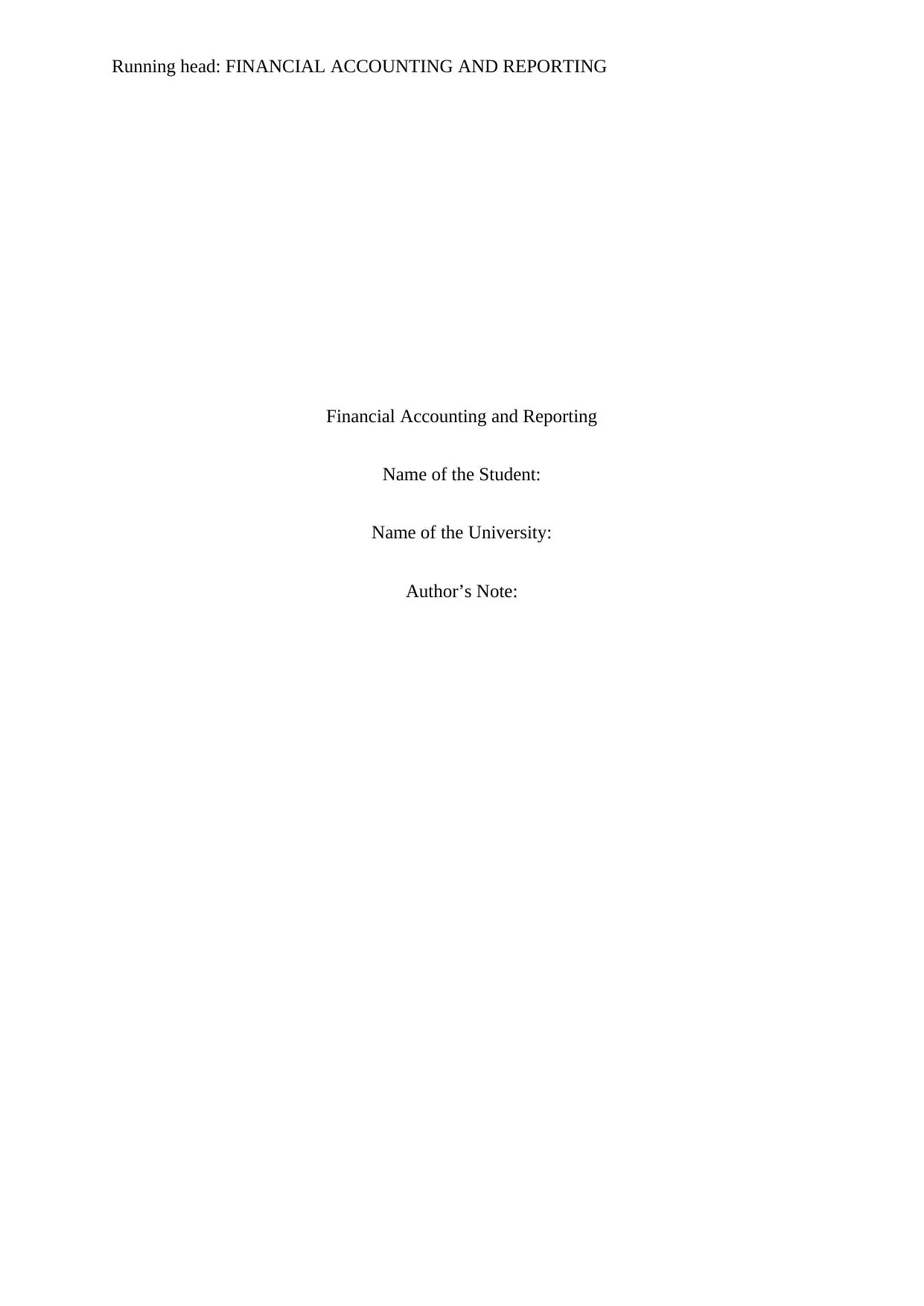
Running head: FINANCIAL ACCOUNTING AND REPORTING
Financial Accounting and Reporting
Name of the Student:
Name of the University:
Author’s Note:
Financial Accounting and Reporting
Name of the Student:
Name of the University:
Author’s Note:
Paraphrase This Document
Need a fresh take? Get an instant paraphrase of this document with our AI Paraphraser
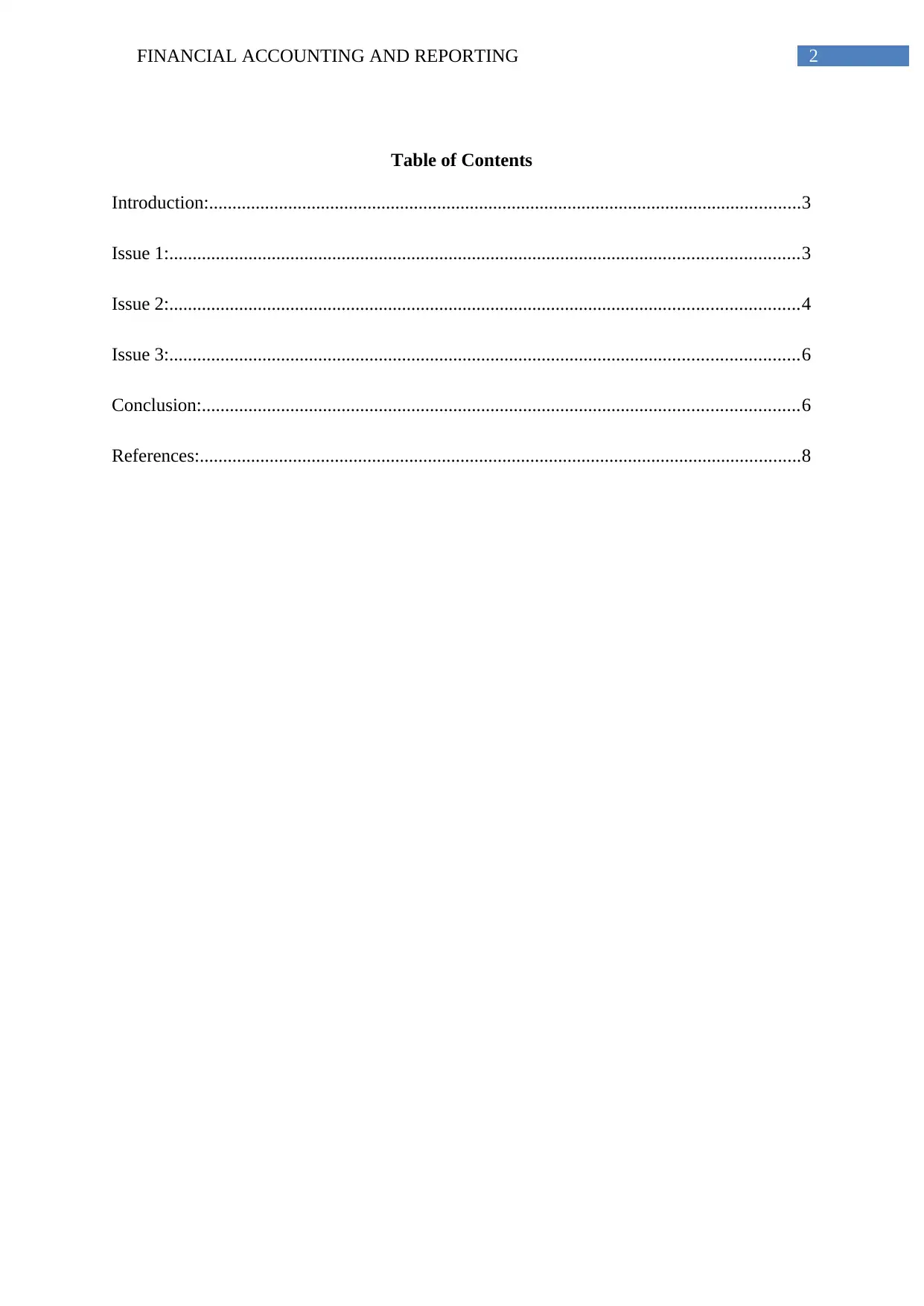
2FINANCIAL ACCOUNTING AND REPORTING
Table of Contents
Introduction:...............................................................................................................................3
Issue 1:.......................................................................................................................................3
Issue 2:.......................................................................................................................................4
Issue 3:.......................................................................................................................................6
Conclusion:................................................................................................................................6
References:.................................................................................................................................8
Table of Contents
Introduction:...............................................................................................................................3
Issue 1:.......................................................................................................................................3
Issue 2:.......................................................................................................................................4
Issue 3:.......................................................................................................................................6
Conclusion:................................................................................................................................6
References:.................................................................................................................................8
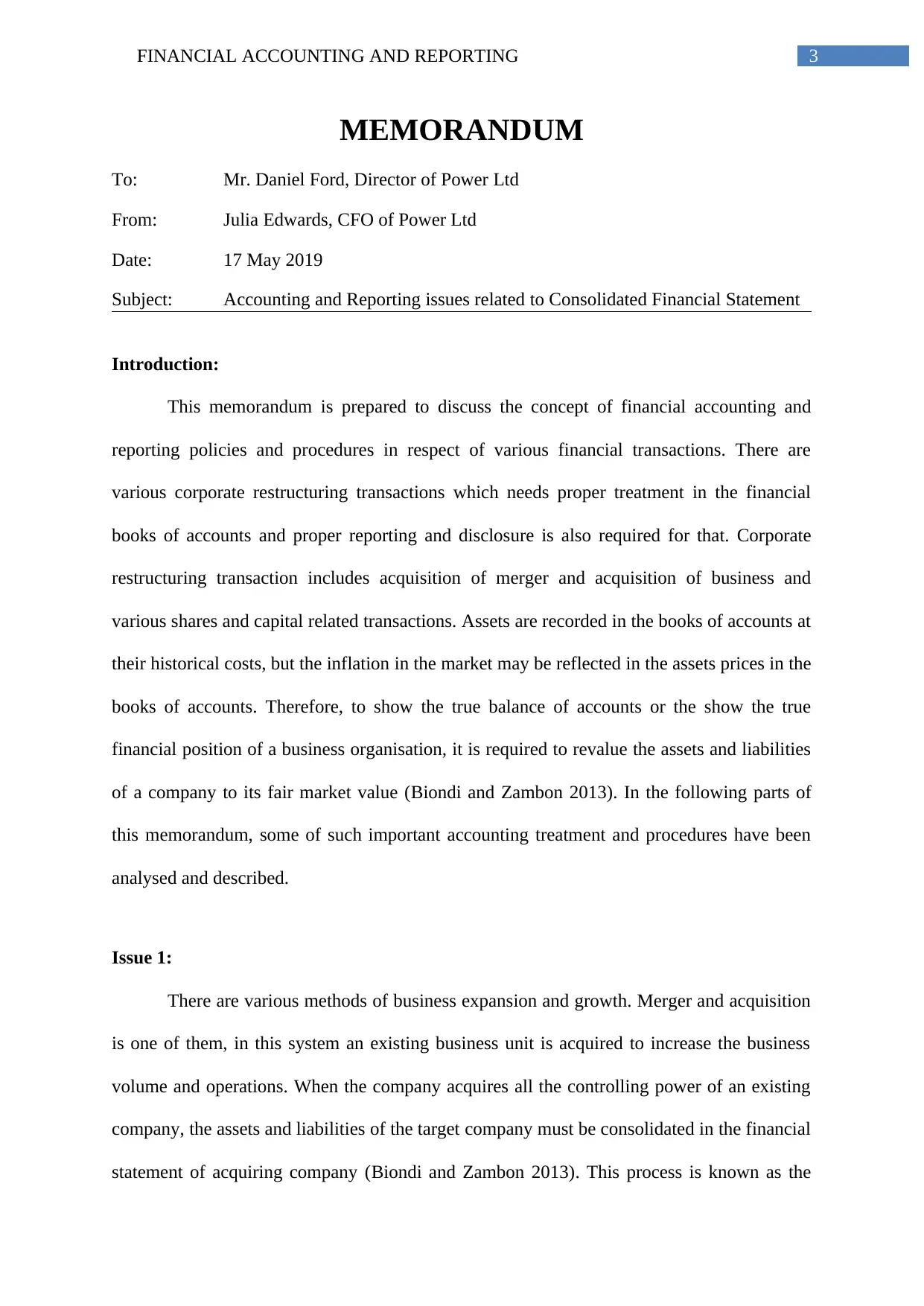
3FINANCIAL ACCOUNTING AND REPORTING
MEMORANDUM
To: Mr. Daniel Ford, Director of Power Ltd
From: Julia Edwards, CFO of Power Ltd
Date: 17 May 2019
Subject: Accounting and Reporting issues related to Consolidated Financial Statement
Introduction:
This memorandum is prepared to discuss the concept of financial accounting and
reporting policies and procedures in respect of various financial transactions. There are
various corporate restructuring transactions which needs proper treatment in the financial
books of accounts and proper reporting and disclosure is also required for that. Corporate
restructuring transaction includes acquisition of merger and acquisition of business and
various shares and capital related transactions. Assets are recorded in the books of accounts at
their historical costs, but the inflation in the market may be reflected in the assets prices in the
books of accounts. Therefore, to show the true balance of accounts or the show the true
financial position of a business organisation, it is required to revalue the assets and liabilities
of a company to its fair market value (Biondi and Zambon 2013). In the following parts of
this memorandum, some of such important accounting treatment and procedures have been
analysed and described.
Issue 1:
There are various methods of business expansion and growth. Merger and acquisition
is one of them, in this system an existing business unit is acquired to increase the business
volume and operations. When the company acquires all the controlling power of an existing
company, the assets and liabilities of the target company must be consolidated in the financial
statement of acquiring company (Biondi and Zambon 2013). This process is known as the
MEMORANDUM
To: Mr. Daniel Ford, Director of Power Ltd
From: Julia Edwards, CFO of Power Ltd
Date: 17 May 2019
Subject: Accounting and Reporting issues related to Consolidated Financial Statement
Introduction:
This memorandum is prepared to discuss the concept of financial accounting and
reporting policies and procedures in respect of various financial transactions. There are
various corporate restructuring transactions which needs proper treatment in the financial
books of accounts and proper reporting and disclosure is also required for that. Corporate
restructuring transaction includes acquisition of merger and acquisition of business and
various shares and capital related transactions. Assets are recorded in the books of accounts at
their historical costs, but the inflation in the market may be reflected in the assets prices in the
books of accounts. Therefore, to show the true balance of accounts or the show the true
financial position of a business organisation, it is required to revalue the assets and liabilities
of a company to its fair market value (Biondi and Zambon 2013). In the following parts of
this memorandum, some of such important accounting treatment and procedures have been
analysed and described.
Issue 1:
There are various methods of business expansion and growth. Merger and acquisition
is one of them, in this system an existing business unit is acquired to increase the business
volume and operations. When the company acquires all the controlling power of an existing
company, the assets and liabilities of the target company must be consolidated in the financial
statement of acquiring company (Biondi and Zambon 2013). This process is known as the
⊘ This is a preview!⊘
Do you want full access?
Subscribe today to unlock all pages.

Trusted by 1+ million students worldwide
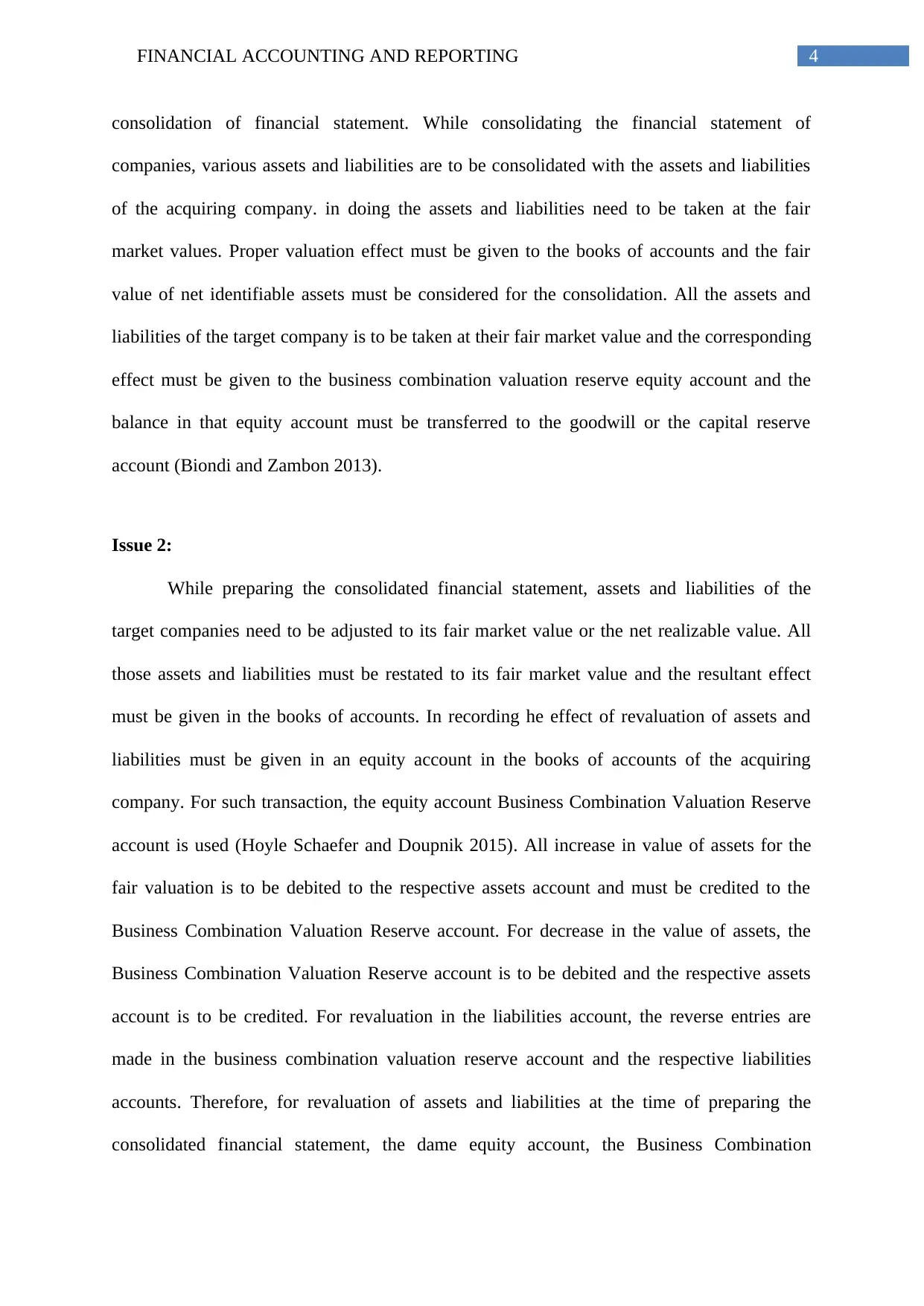
4FINANCIAL ACCOUNTING AND REPORTING
consolidation of financial statement. While consolidating the financial statement of
companies, various assets and liabilities are to be consolidated with the assets and liabilities
of the acquiring company. in doing the assets and liabilities need to be taken at the fair
market values. Proper valuation effect must be given to the books of accounts and the fair
value of net identifiable assets must be considered for the consolidation. All the assets and
liabilities of the target company is to be taken at their fair market value and the corresponding
effect must be given to the business combination valuation reserve equity account and the
balance in that equity account must be transferred to the goodwill or the capital reserve
account (Biondi and Zambon 2013).
Issue 2:
While preparing the consolidated financial statement, assets and liabilities of the
target companies need to be adjusted to its fair market value or the net realizable value. All
those assets and liabilities must be restated to its fair market value and the resultant effect
must be given in the books of accounts. In recording he effect of revaluation of assets and
liabilities must be given in an equity account in the books of accounts of the acquiring
company. For such transaction, the equity account Business Combination Valuation Reserve
account is used (Hoyle Schaefer and Doupnik 2015). All increase in value of assets for the
fair valuation is to be debited to the respective assets account and must be credited to the
Business Combination Valuation Reserve account. For decrease in the value of assets, the
Business Combination Valuation Reserve account is to be debited and the respective assets
account is to be credited. For revaluation in the liabilities account, the reverse entries are
made in the business combination valuation reserve account and the respective liabilities
accounts. Therefore, for revaluation of assets and liabilities at the time of preparing the
consolidated financial statement, the dame equity account, the Business Combination
consolidation of financial statement. While consolidating the financial statement of
companies, various assets and liabilities are to be consolidated with the assets and liabilities
of the acquiring company. in doing the assets and liabilities need to be taken at the fair
market values. Proper valuation effect must be given to the books of accounts and the fair
value of net identifiable assets must be considered for the consolidation. All the assets and
liabilities of the target company is to be taken at their fair market value and the corresponding
effect must be given to the business combination valuation reserve equity account and the
balance in that equity account must be transferred to the goodwill or the capital reserve
account (Biondi and Zambon 2013).
Issue 2:
While preparing the consolidated financial statement, assets and liabilities of the
target companies need to be adjusted to its fair market value or the net realizable value. All
those assets and liabilities must be restated to its fair market value and the resultant effect
must be given in the books of accounts. In recording he effect of revaluation of assets and
liabilities must be given in an equity account in the books of accounts of the acquiring
company. For such transaction, the equity account Business Combination Valuation Reserve
account is used (Hoyle Schaefer and Doupnik 2015). All increase in value of assets for the
fair valuation is to be debited to the respective assets account and must be credited to the
Business Combination Valuation Reserve account. For decrease in the value of assets, the
Business Combination Valuation Reserve account is to be debited and the respective assets
account is to be credited. For revaluation in the liabilities account, the reverse entries are
made in the business combination valuation reserve account and the respective liabilities
accounts. Therefore, for revaluation of assets and liabilities at the time of preparing the
consolidated financial statement, the dame equity account, the Business Combination
Paraphrase This Document
Need a fresh take? Get an instant paraphrase of this document with our AI Paraphraser
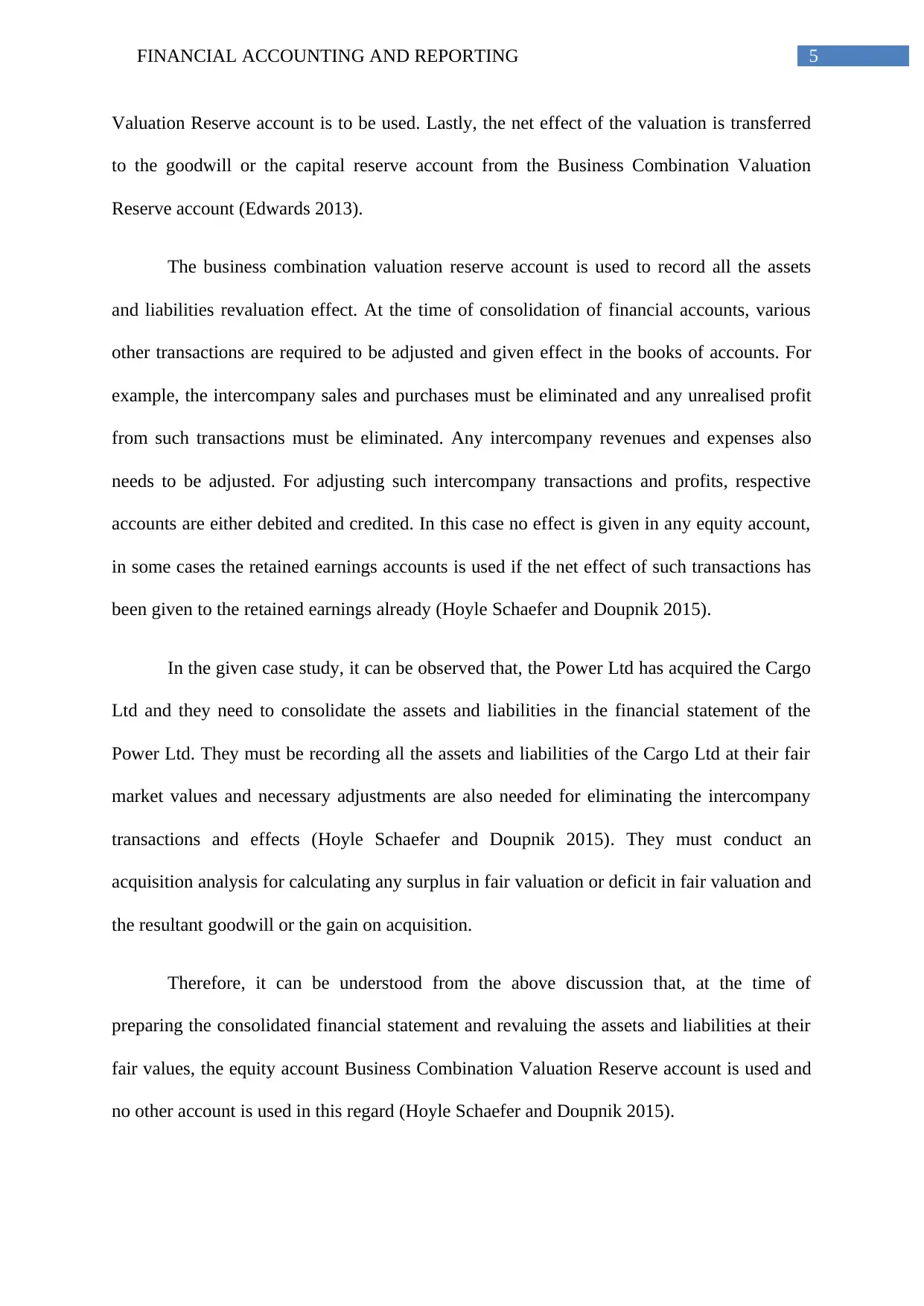
5FINANCIAL ACCOUNTING AND REPORTING
Valuation Reserve account is to be used. Lastly, the net effect of the valuation is transferred
to the goodwill or the capital reserve account from the Business Combination Valuation
Reserve account (Edwards 2013).
The business combination valuation reserve account is used to record all the assets
and liabilities revaluation effect. At the time of consolidation of financial accounts, various
other transactions are required to be adjusted and given effect in the books of accounts. For
example, the intercompany sales and purchases must be eliminated and any unrealised profit
from such transactions must be eliminated. Any intercompany revenues and expenses also
needs to be adjusted. For adjusting such intercompany transactions and profits, respective
accounts are either debited and credited. In this case no effect is given in any equity account,
in some cases the retained earnings accounts is used if the net effect of such transactions has
been given to the retained earnings already (Hoyle Schaefer and Doupnik 2015).
In the given case study, it can be observed that, the Power Ltd has acquired the Cargo
Ltd and they need to consolidate the assets and liabilities in the financial statement of the
Power Ltd. They must be recording all the assets and liabilities of the Cargo Ltd at their fair
market values and necessary adjustments are also needed for eliminating the intercompany
transactions and effects (Hoyle Schaefer and Doupnik 2015). They must conduct an
acquisition analysis for calculating any surplus in fair valuation or deficit in fair valuation and
the resultant goodwill or the gain on acquisition.
Therefore, it can be understood from the above discussion that, at the time of
preparing the consolidated financial statement and revaluing the assets and liabilities at their
fair values, the equity account Business Combination Valuation Reserve account is used and
no other account is used in this regard (Hoyle Schaefer and Doupnik 2015).
Valuation Reserve account is to be used. Lastly, the net effect of the valuation is transferred
to the goodwill or the capital reserve account from the Business Combination Valuation
Reserve account (Edwards 2013).
The business combination valuation reserve account is used to record all the assets
and liabilities revaluation effect. At the time of consolidation of financial accounts, various
other transactions are required to be adjusted and given effect in the books of accounts. For
example, the intercompany sales and purchases must be eliminated and any unrealised profit
from such transactions must be eliminated. Any intercompany revenues and expenses also
needs to be adjusted. For adjusting such intercompany transactions and profits, respective
accounts are either debited and credited. In this case no effect is given in any equity account,
in some cases the retained earnings accounts is used if the net effect of such transactions has
been given to the retained earnings already (Hoyle Schaefer and Doupnik 2015).
In the given case study, it can be observed that, the Power Ltd has acquired the Cargo
Ltd and they need to consolidate the assets and liabilities in the financial statement of the
Power Ltd. They must be recording all the assets and liabilities of the Cargo Ltd at their fair
market values and necessary adjustments are also needed for eliminating the intercompany
transactions and effects (Hoyle Schaefer and Doupnik 2015). They must conduct an
acquisition analysis for calculating any surplus in fair valuation or deficit in fair valuation and
the resultant goodwill or the gain on acquisition.
Therefore, it can be understood from the above discussion that, at the time of
preparing the consolidated financial statement and revaluing the assets and liabilities at their
fair values, the equity account Business Combination Valuation Reserve account is used and
no other account is used in this regard (Hoyle Schaefer and Doupnik 2015).
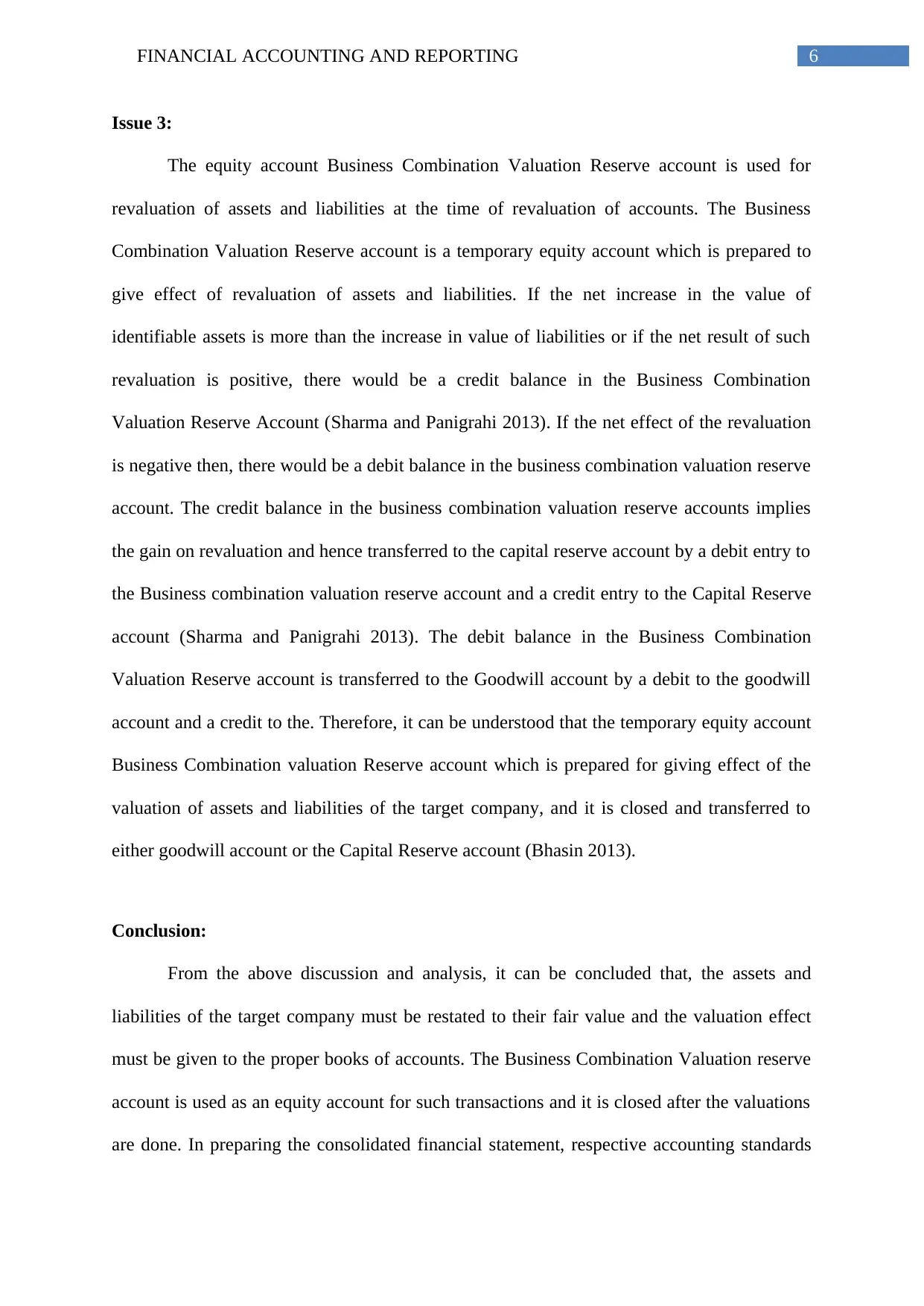
6FINANCIAL ACCOUNTING AND REPORTING
Issue 3:
The equity account Business Combination Valuation Reserve account is used for
revaluation of assets and liabilities at the time of revaluation of accounts. The Business
Combination Valuation Reserve account is a temporary equity account which is prepared to
give effect of revaluation of assets and liabilities. If the net increase in the value of
identifiable assets is more than the increase in value of liabilities or if the net result of such
revaluation is positive, there would be a credit balance in the Business Combination
Valuation Reserve Account (Sharma and Panigrahi 2013). If the net effect of the revaluation
is negative then, there would be a debit balance in the business combination valuation reserve
account. The credit balance in the business combination valuation reserve accounts implies
the gain on revaluation and hence transferred to the capital reserve account by a debit entry to
the Business combination valuation reserve account and a credit entry to the Capital Reserve
account (Sharma and Panigrahi 2013). The debit balance in the Business Combination
Valuation Reserve account is transferred to the Goodwill account by a debit to the goodwill
account and a credit to the. Therefore, it can be understood that the temporary equity account
Business Combination valuation Reserve account which is prepared for giving effect of the
valuation of assets and liabilities of the target company, and it is closed and transferred to
either goodwill account or the Capital Reserve account (Bhasin 2013).
Conclusion:
From the above discussion and analysis, it can be concluded that, the assets and
liabilities of the target company must be restated to their fair value and the valuation effect
must be given to the proper books of accounts. The Business Combination Valuation reserve
account is used as an equity account for such transactions and it is closed after the valuations
are done. In preparing the consolidated financial statement, respective accounting standards
Issue 3:
The equity account Business Combination Valuation Reserve account is used for
revaluation of assets and liabilities at the time of revaluation of accounts. The Business
Combination Valuation Reserve account is a temporary equity account which is prepared to
give effect of revaluation of assets and liabilities. If the net increase in the value of
identifiable assets is more than the increase in value of liabilities or if the net result of such
revaluation is positive, there would be a credit balance in the Business Combination
Valuation Reserve Account (Sharma and Panigrahi 2013). If the net effect of the revaluation
is negative then, there would be a debit balance in the business combination valuation reserve
account. The credit balance in the business combination valuation reserve accounts implies
the gain on revaluation and hence transferred to the capital reserve account by a debit entry to
the Business combination valuation reserve account and a credit entry to the Capital Reserve
account (Sharma and Panigrahi 2013). The debit balance in the Business Combination
Valuation Reserve account is transferred to the Goodwill account by a debit to the goodwill
account and a credit to the. Therefore, it can be understood that the temporary equity account
Business Combination valuation Reserve account which is prepared for giving effect of the
valuation of assets and liabilities of the target company, and it is closed and transferred to
either goodwill account or the Capital Reserve account (Bhasin 2013).
Conclusion:
From the above discussion and analysis, it can be concluded that, the assets and
liabilities of the target company must be restated to their fair value and the valuation effect
must be given to the proper books of accounts. The Business Combination Valuation reserve
account is used as an equity account for such transactions and it is closed after the valuations
are done. In preparing the consolidated financial statement, respective accounting standards
⊘ This is a preview!⊘
Do you want full access?
Subscribe today to unlock all pages.

Trusted by 1+ million students worldwide
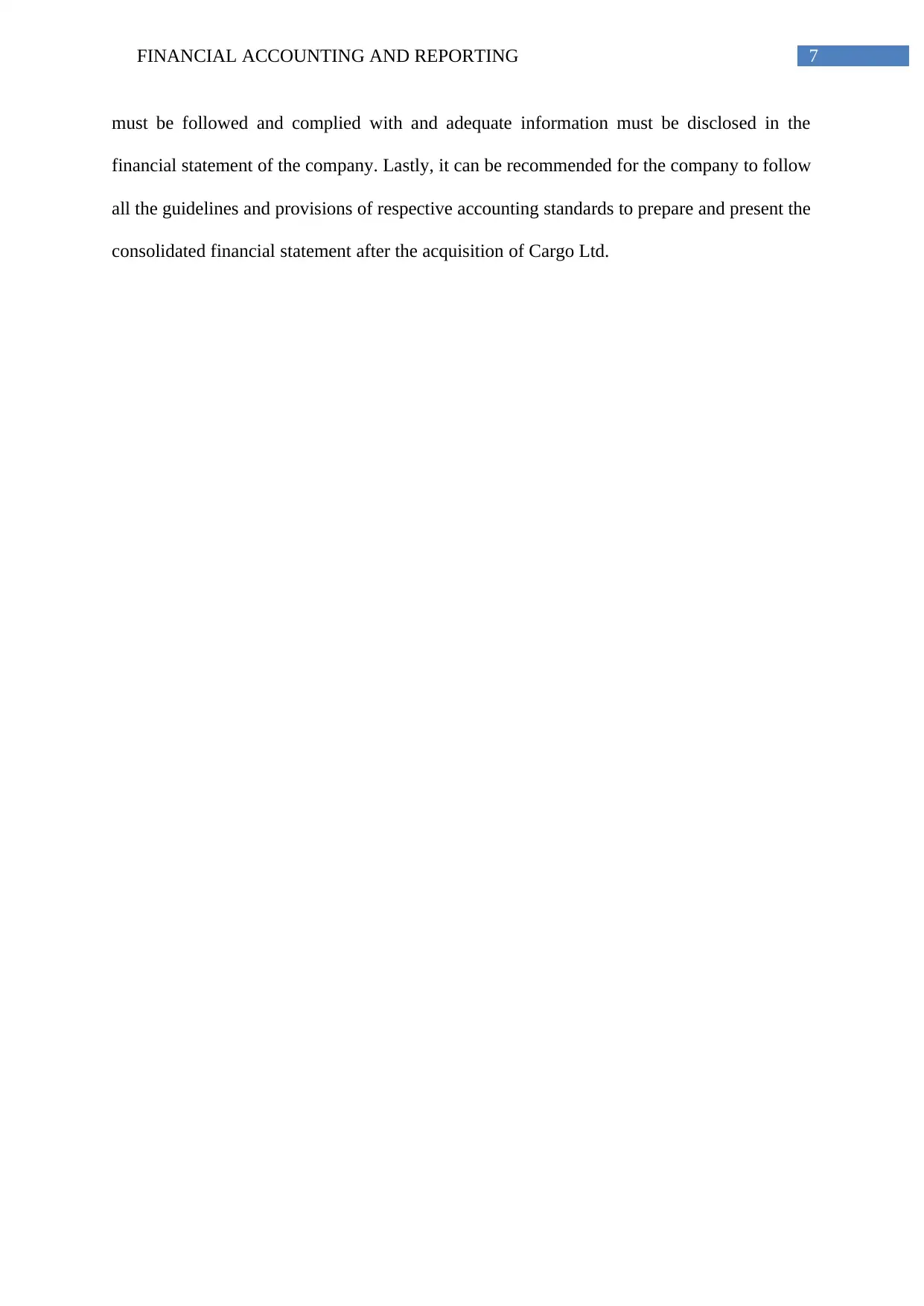
7FINANCIAL ACCOUNTING AND REPORTING
must be followed and complied with and adequate information must be disclosed in the
financial statement of the company. Lastly, it can be recommended for the company to follow
all the guidelines and provisions of respective accounting standards to prepare and present the
consolidated financial statement after the acquisition of Cargo Ltd.
must be followed and complied with and adequate information must be disclosed in the
financial statement of the company. Lastly, it can be recommended for the company to follow
all the guidelines and provisions of respective accounting standards to prepare and present the
consolidated financial statement after the acquisition of Cargo Ltd.
Paraphrase This Document
Need a fresh take? Get an instant paraphrase of this document with our AI Paraphraser
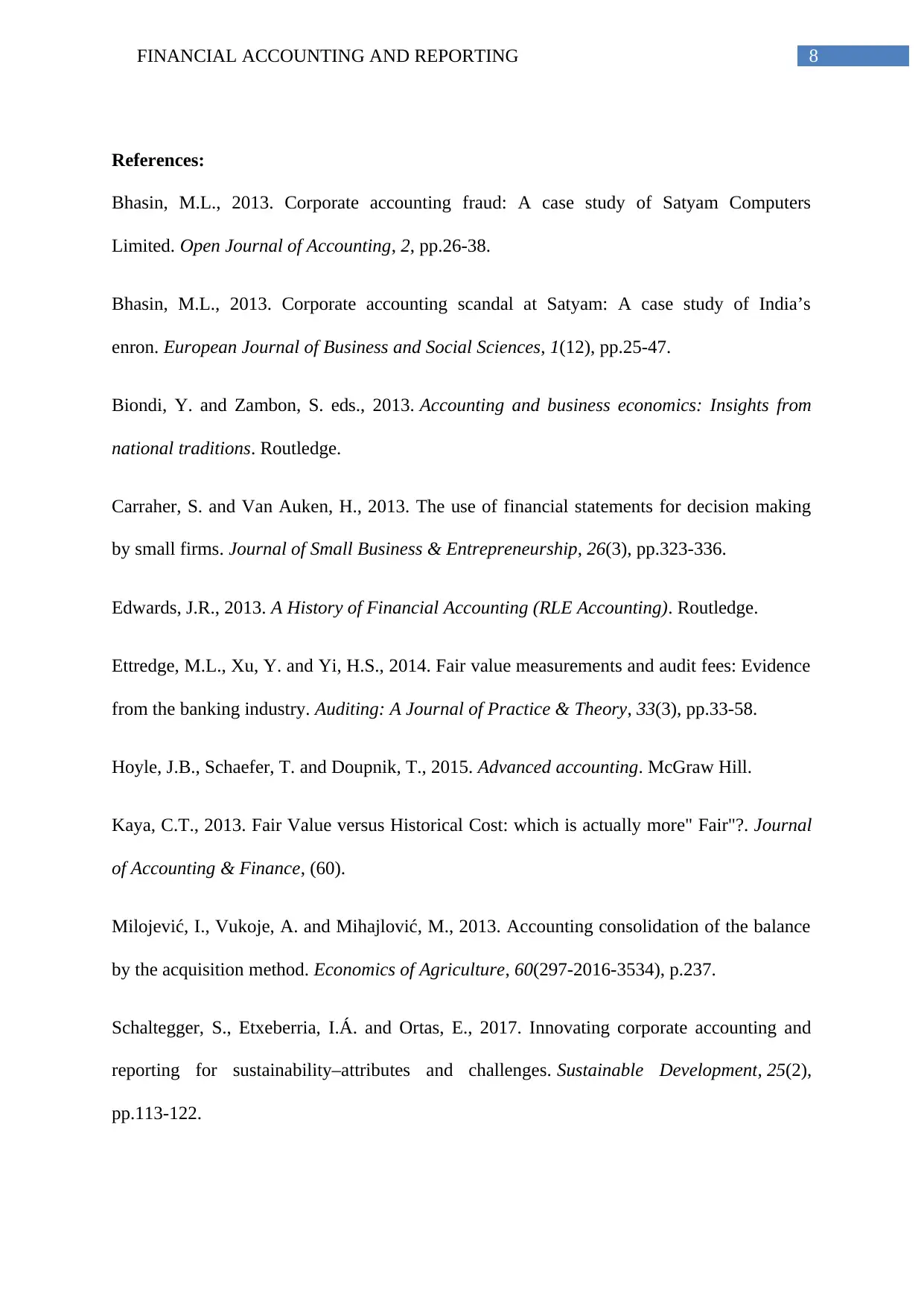
8FINANCIAL ACCOUNTING AND REPORTING
References:
Bhasin, M.L., 2013. Corporate accounting fraud: A case study of Satyam Computers
Limited. Open Journal of Accounting, 2, pp.26-38.
Bhasin, M.L., 2013. Corporate accounting scandal at Satyam: A case study of India’s
enron. European Journal of Business and Social Sciences, 1(12), pp.25-47.
Biondi, Y. and Zambon, S. eds., 2013. Accounting and business economics: Insights from
national traditions. Routledge.
Carraher, S. and Van Auken, H., 2013. The use of financial statements for decision making
by small firms. Journal of Small Business & Entrepreneurship, 26(3), pp.323-336.
Edwards, J.R., 2013. A History of Financial Accounting (RLE Accounting). Routledge.
Ettredge, M.L., Xu, Y. and Yi, H.S., 2014. Fair value measurements and audit fees: Evidence
from the banking industry. Auditing: A Journal of Practice & Theory, 33(3), pp.33-58.
Hoyle, J.B., Schaefer, T. and Doupnik, T., 2015. Advanced accounting. McGraw Hill.
Kaya, C.T., 2013. Fair Value versus Historical Cost: which is actually more" Fair"?. Journal
of Accounting & Finance, (60).
Milojević, I., Vukoje, A. and Mihajlović, M., 2013. Accounting consolidation of the balance
by the acquisition method. Economics of Agriculture, 60(297-2016-3534), p.237.
Schaltegger, S., Etxeberria, I.Á. and Ortas, E., 2017. Innovating corporate accounting and
reporting for sustainability–attributes and challenges. Sustainable Development, 25(2),
pp.113-122.
References:
Bhasin, M.L., 2013. Corporate accounting fraud: A case study of Satyam Computers
Limited. Open Journal of Accounting, 2, pp.26-38.
Bhasin, M.L., 2013. Corporate accounting scandal at Satyam: A case study of India’s
enron. European Journal of Business and Social Sciences, 1(12), pp.25-47.
Biondi, Y. and Zambon, S. eds., 2013. Accounting and business economics: Insights from
national traditions. Routledge.
Carraher, S. and Van Auken, H., 2013. The use of financial statements for decision making
by small firms. Journal of Small Business & Entrepreneurship, 26(3), pp.323-336.
Edwards, J.R., 2013. A History of Financial Accounting (RLE Accounting). Routledge.
Ettredge, M.L., Xu, Y. and Yi, H.S., 2014. Fair value measurements and audit fees: Evidence
from the banking industry. Auditing: A Journal of Practice & Theory, 33(3), pp.33-58.
Hoyle, J.B., Schaefer, T. and Doupnik, T., 2015. Advanced accounting. McGraw Hill.
Kaya, C.T., 2013. Fair Value versus Historical Cost: which is actually more" Fair"?. Journal
of Accounting & Finance, (60).
Milojević, I., Vukoje, A. and Mihajlović, M., 2013. Accounting consolidation of the balance
by the acquisition method. Economics of Agriculture, 60(297-2016-3534), p.237.
Schaltegger, S., Etxeberria, I.Á. and Ortas, E., 2017. Innovating corporate accounting and
reporting for sustainability–attributes and challenges. Sustainable Development, 25(2),
pp.113-122.
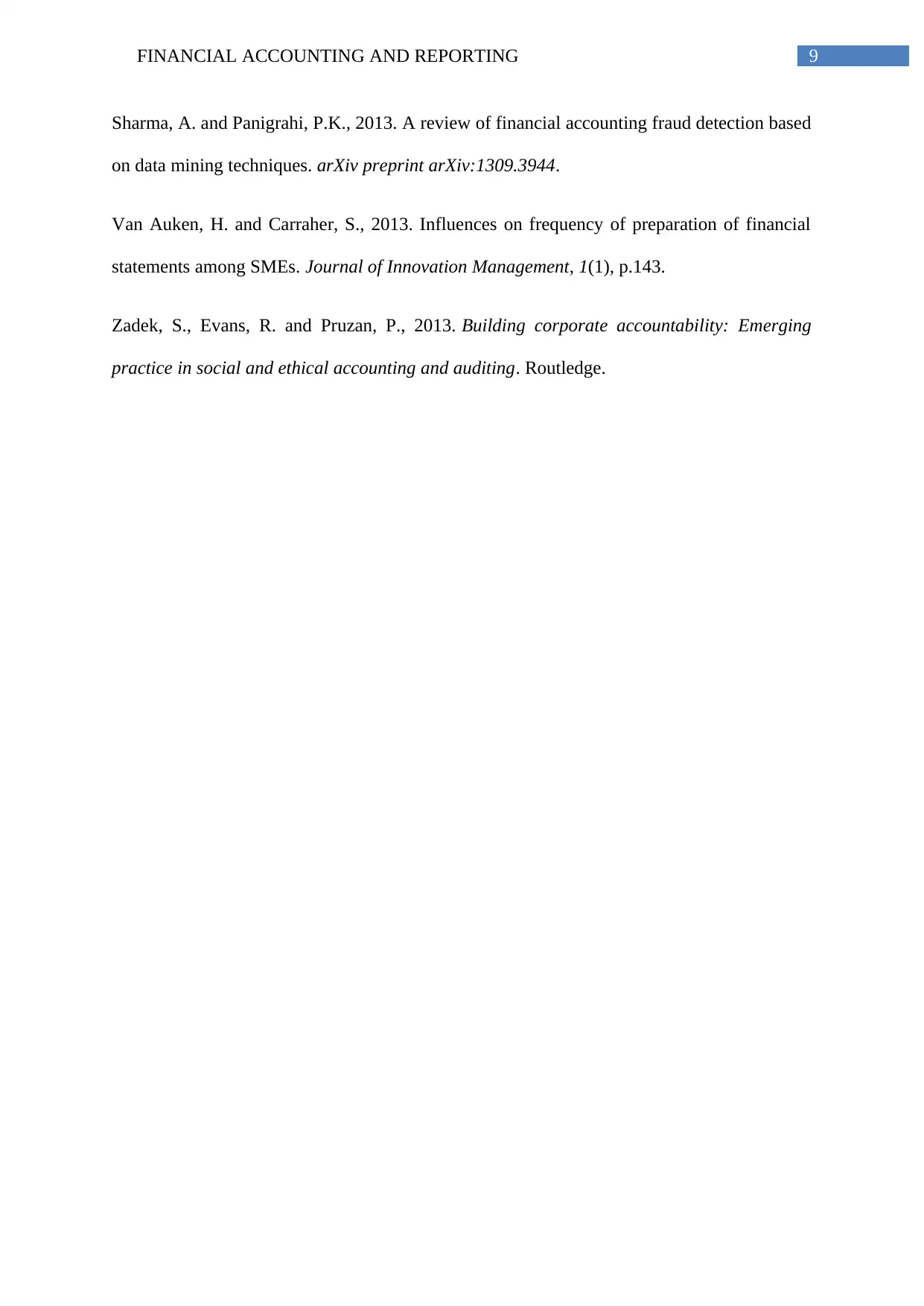
9FINANCIAL ACCOUNTING AND REPORTING
Sharma, A. and Panigrahi, P.K., 2013. A review of financial accounting fraud detection based
on data mining techniques. arXiv preprint arXiv:1309.3944.
Van Auken, H. and Carraher, S., 2013. Influences on frequency of preparation of financial
statements among SMEs. Journal of Innovation Management, 1(1), p.143.
Zadek, S., Evans, R. and Pruzan, P., 2013. Building corporate accountability: Emerging
practice in social and ethical accounting and auditing. Routledge.
Sharma, A. and Panigrahi, P.K., 2013. A review of financial accounting fraud detection based
on data mining techniques. arXiv preprint arXiv:1309.3944.
Van Auken, H. and Carraher, S., 2013. Influences on frequency of preparation of financial
statements among SMEs. Journal of Innovation Management, 1(1), p.143.
Zadek, S., Evans, R. and Pruzan, P., 2013. Building corporate accountability: Emerging
practice in social and ethical accounting and auditing. Routledge.
⊘ This is a preview!⊘
Do you want full access?
Subscribe today to unlock all pages.

Trusted by 1+ million students worldwide
1 out of 9
Related Documents
Your All-in-One AI-Powered Toolkit for Academic Success.
+13062052269
info@desklib.com
Available 24*7 on WhatsApp / Email
![[object Object]](/_next/static/media/star-bottom.7253800d.svg)
Unlock your academic potential
Copyright © 2020–2025 A2Z Services. All Rights Reserved. Developed and managed by ZUCOL.





